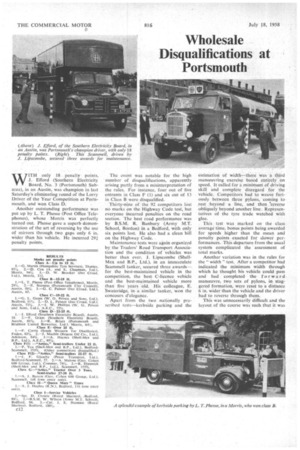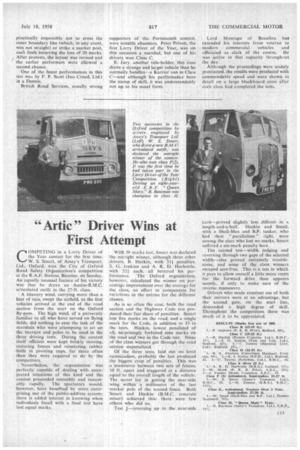Wholesale Disqualifications at Portsmouth
Page 50

Page 51

If you've noticed an error in this article please click here to report it so we can fix it.
WITH only 18 penalty points, -I. Efford (Southern Electricity Board, No. 3 (Portsmouth) Subarea), in an Austin, was champion in last Saturday's eliminating round of the Lorry Driver of the Year Competition at Portsmouth, and won Class D.
Another outstanding performance was put up by L. T. Phesse (Post Office Telephones), whose Morris was perfectly turned out. Phesse gave a superb demonstration of the art of reversing by the use of mirrors through two gaps only 6 in. wider than his vehicle. He incurred 29:1penalty points. The event was notable for the high number of disqualifications, apparently arising partly from a misinterpretation of the rules. For instance, four out of five entrants in Class F (1) and six out of 13 in Class B were disqualified.
Thirty-nine of the 92 competitors lost no marks on the Highway Code test, but everyone incurred penalties on the road section. The best road performance was by B.S.M. R. Banbury (Army M.T. School, Bordon) in a Bedford, with only six points lost. He also had a clean bill on the Highway Code. .
Maintenance tests were again organized by the Traders' Road Transport Association and the condition of vehicles was better than ever. J. Lipscombe (ShellMex and B.P., Ltd.), in an immaculate Scammell tanker, secured three awards'— for the best-maintained vehicle in the competition, the best C-licence vehicle and the best-maintained vehicle more than five years old. His colleague, E. Swateridge, in a similar tanker, won the concours d'elegance.
Apart from the two nationally prescribed tests—kerbside parking and the
estimation of width—there was a third manceuvring exercise based entirely on speed. It called for a minimum of driving skill and complete disregard for the vehicle. Competitors had to weave furiously between three pYlons, coming torest beyond a line, and then 'reverse obliquely beyond another line. Representatives of the tyre trade watched with glee.
This test was marked on the class average time, bonus points being awarded for speeds higher than the mean and penalty points exacted for slower performances. This departure from the usual systefn complicated the assessment of total marks.
Another variation was in the rules for the " width " test. After a competitor had indicated the minimum width through which he thought his vehicle could pass and had completed the f o r wa rd manceuvre, two sets of pylons, in staggered formation, were reset to a distance 6 in. wider than the vehicle and the driver had to reverse through them.
This was unnecessarily difficult and the layout of the course was such that it was practically impossible not to cross the outer boundary line (which, in any event, was not straight) or strike a marker post, each fault incurring the loss of 20 marks. After protests, the layout was revised and the earlier performers were allowed a second chance.
One of the finest perforrnances in this test was by F. P. Scott (Jno Croad, Ltd.) in a Dennis.
British Road Services, usually strong supporters of the Portsmouth contest, were notable absentees. Peter Privett, the first Lorry Driver of the Year, was on this occasion a marshal, but one of his drivers won Class C.
E. Jury, another title-holder, this time droVe a strange and larger vehicle than he normally handles--a Karrier van in Class C—and although his performance bore the stamp of skill, it was Understandably not up to his usual form. Lord Montagu of Beaulieu has extended his interests from veteran to modern commercial vehicles and officiated as clerk of the course. He was active in that capacity throughout the day.
Although the proceedings were unduly protracted, the results were produced with commendable speed and were shown in detail on a large blackboard soon after each class had completed the tests.












































































































